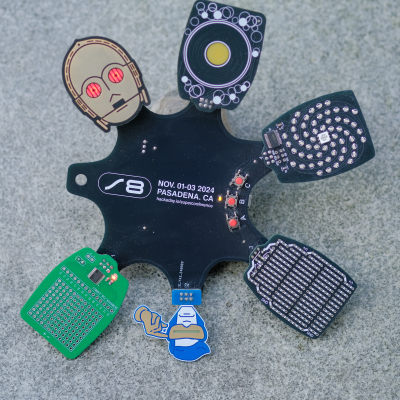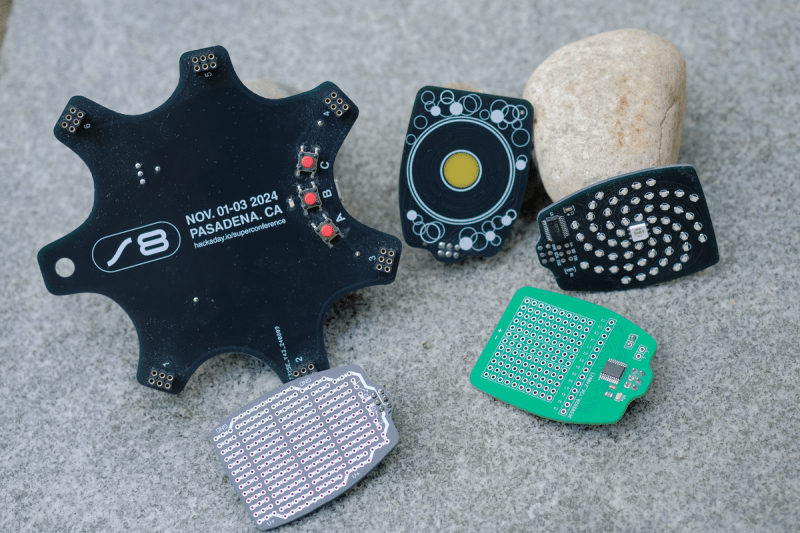We’ve been hinting at it for a few months now, running a series of articles on SAOs, then a Supercon Add-On Challenge. We even let on that the badge would have space for multiple SAOs this year, but would you believe six?
Way back in 2017ish, Hackaday’s own [Brian Benchoff] and the [AND!XOR] crew thought it would be funny and useful to create a “standard” for adding small custom PCB art-badges onto bigger conference badges. The idea was to keep it quick and dirty, uncomplicated and hacky, and the “Shitty” Add On was born. The badge community took to this like wildfire. While the community has moved on from the fecal humor, whether you call these little badgelets “SAOs”, “Simple Add-Ons”, or even “Supercon-8 Add Ons”, there’s something here for everyone. So if you’ve already got some SAOs in a drawer, bring them to this year’s Supercon and show them off!
But you don’t need to bring your own SAOs. We thought that as long as we were providing six SAO ports, we’d provide you with a small starter collection: four of them, in fact. A fantastic capacitive touch wheel designed by [Todbot], a beautiful spiral petal matrix of LEDs designed by [Voja Antonic], a completely blank-slate protoboard petal, and an I2C-enabled microcontroller proto-petal.
 Bringing it all together, of course, is the main badge, which sports a Raspberry Pi Pico W on the back-side, for WiFi and Bluetooth connectivity. This badge is intended to be a showcase of SAOs, and we thought that there have always been some under-explored corners of the spec. The most recent six-pin standard has power, ground, two GPIO pins, and an I2C pair. How often do we see SAOs that only use the power lines? This year, that changes!
Bringing it all together, of course, is the main badge, which sports a Raspberry Pi Pico W on the back-side, for WiFi and Bluetooth connectivity. This badge is intended to be a showcase of SAOs, and we thought that there have always been some under-explored corners of the spec. The most recent six-pin standard has power, ground, two GPIO pins, and an I2C pair. How often do we see SAOs that only use the power lines? This year, that changes!
Every GPIO pin on all six SAO slots is individually accessible, and the Pi Pico’s two hardware I2C peripheral busses are broken out on the left and right sides of the badge respectively. (Have an I2C enumeration conflict? Just move one of the offenders to the other side.) The idea here, combined with the wireless features and a trio of buttons on the front, is to give you a big sandbox to explore the possibilities of SAOs that go farther than just art.
Many Ways to Play
Straight out of the gate, the touch wheel and the LED petal matrix invite you to play with them, all the while fooling you into learning a little bit about interfacing I2C devices. You see, I2C devices have a unique address, and the rest of the functionality is handled by as if they were memory-mapped peripherals. What does this mean? If you want to ask the touch wheel where your finger is, you simply query its memory location 0. To set the LED colors, you write bytes to memory locations 15, 16, and 17 for red, green, and blue, respectively. Each spiral arm of the LED matrix petal is simply a byte in memory – write to it and the blinkies blink.
The take-home: I2C devices are fun and to play with. And when you start combining the functions of multiple SAOs, you can really start getting creative. But we’ve only scratched the surface. The I2C proto petal includes a CH32V003 chip, with its own dedicated I2C device hardware peripheral, so if you have essentially anything that you can solder to it, you can turn that into an I2C-enabled device to add to the party.
This is a multi-lingual party, though. The main badge, and all of the connection logic, runs on MicroPython. This makes it just a few lines of code to display your finger presses on the touchwheel over on the LED petal matrix, for instance, and we’ll have some demo code to ease you in. (And we’re frantically writing more!) But the I2C protoboard requires a little bit of C. If you’ve got a CH32V003 environment set up, by all means bring it – we love [CHLohr]’s CH32V003fun. We’re working on getting the badge board to program the CH32 in-situ, and we’re 99% sure we’ll have that ready by showtime. We’ll have demo code here to get you started as well. Will you program your first RISC-V chip at this year’s Supercon?
But say you don’t want anything to do with all this software? Just give me the solder! The blank-slate protoboard is for you. It breaks out the SAO lines, and gives you maximal room for creative hardware play. Heck, you could solder an LED, a resistor, and call it done. Or play around with the possibilities of the GPIOs. Low-code or no-code, the choice is yours.
Participate!
We know you’re all looking forward to getting your hands on the badge and the SAOs and getting creative. Here is the 2024 Supercon SAO Badge GitHub repository, for your perusal. All of the design files that we have are there in the hardware directory, but the code is not yet complete. If you want to design a 3D-printed case or add-on, you’ll find the vector files in PDF.
As usual [Voja] makes his circuit diagrams by hand, so you’ll find a beautifully annotated schematic that lets you know where each and every pin goes. If you’re not feeling the AA battery love, you’ll see that [Voja] has left you some pads to hook up an external power supply, for instance.
But the software is a work in progress, and in particular, we don’t know what I2C devices you’ll be bringing with you. We’re going to include as many MicroPython I2C device libraries as we can find, from OLED screens to magnetometers, and we’d like them to be on the default conference image. So if you’ve a device that you’d like us to support, either drop a link in the comments below or add the code in the libraries folder and submit a pull request! We’ll be flashing these at the absolute last minute, of course, but please get it in this weekend if you can.
Supercon!
 Supercon 8’s badge is the unofficial world-record holder for the most SAO connectors on any official conference badge, but it also aspires to encourage you to play around with the functional aspects of our favorite mini-badge form factor. Heck, maybe you’ll learn a thing or two about I2C along the way? Push some GPIOs around? Or maybe you’ll just have a fun weekend with a soldering iron, some stellar talks, and some great company. Whatever it’s going to be, we can’t wait to see you all, and to see what you come up with!
Supercon 8’s badge is the unofficial world-record holder for the most SAO connectors on any official conference badge, but it also aspires to encourage you to play around with the functional aspects of our favorite mini-badge form factor. Heck, maybe you’ll learn a thing or two about I2C along the way? Push some GPIOs around? Or maybe you’ll just have a fun weekend with a soldering iron, some stellar talks, and some great company. Whatever it’s going to be, we can’t wait to see you all, and to see what you come up with!
If you have any questions about the badge, fire away in the comments here.
You do have your tickets already, right? See you soon!
(C3P0 add-on by [kuro_dk] and Cyclops by [Simenzhor] not included.)




















Finally!
(Sigh!)
“All of the design files that we have are there in the hardware directory, but the code is not yet complete. If you want to design a 3D-printed case or add-on, you’ll find the vector files in PDF.”
So, those of us who can’t attend can play at home!
Seriously, so many badges (it seems) use an obscure processor* or other chip(s) which make it difficult to make our own.
*overstock, or from a reel the designer wants to get rid of…
Well, if there was ever a Supercon badge to make a DIY copy of, this is certainly the one. It’s about as straightforward as it can possibly be.
The badge itself is straightforward, but it’s nothing without the SAOs. Of course those are basically individually simple as well…
Badges use weird processors because designers want to play with weird processors, without necessarily committing a significant project to them. Badges fit the bill perfectly.
Okay, I’ll agree to that also!
To quote ‘The Exploited’ …. Punk’s not dead!
Are the petals all the same footprint/silhouette? I’m thinking of 3D printing a diffuser for the petal matrix.
That would be fun! They are almost identical…
The touchwheel and the I2C expander are identical, and the outline is here: https://github.com/Hack-a-Day/2024-Supercon-8-Add-On-Badge/blob/main/hardware/sao/i2c_proto_petal/sao_proto-Edge_Cuts.svg
The LED spiral matrix and the pure proto petals are a tiny bit different, when I lay them on top of each other. The gerbers are there, but I’ll see about getting the outline out easier.
tyvm!
I think I solved my own need, so long as the Petal_Matrix.ps file is dimensionally accurate: https://github.com/Hack-a-Day/2024-Supercon-8-Add-On-Badge/pull/2
Awesome. I’ll have a look. Voja also tells me that the outlines are in that Altium designer file .pcbxyzbbq
We use them for a few days then they end up in the trash.
Why would you throw these in the trash?
This one should have a decent afterlife. It makes a great desk display, if you’ve got a few SAOs that you want to show off, frinstance.
But practically, I’m going to use mine as a WiFi / I2C sensor bridge for home automation stuff. Temp / humidity / barometric pressure sensor and good to go.
I don’t think I’ve ever thrown any conference badge in the trash, though. A drawer where they seldom see the light of day? Perhaps! But every once in a while I’ll pull them out and they’re still fun to show off to nerdy friends. They would make an awesome wall display, if I ever got around to it.
Next time you have one you don’t want, let me know and I’ll pay postage.
“Bringing it all together, of course, is the main badge, which sports a Raspberry Pi Pico W on the back-side, for WiFi and Bluetooth”
You’d throw that in the trash?
I find this one rather disappointing because you can’t really do anything with it unless you spend your entire con badge hacking instead of attending the talks.
I generally enjoyed sitting in the back of the lecture tapping out my 4 bit assembly code or basic program while listening and occasionally looking up at slides.
Ah well.
I’m bringing a huge table of junk for badge hacking people to do something with. Maybe somebody will use it as a general processor and make something interesting with it.
“unless you spend your entire con badge hacking instead of attending the talks”…
I hope you’ll be pleasantly surprised then.
:-|
A badge for a hardware hacker con that expects you to actually do hardware hacking?? What a crazy idea.
Tables of hardware “junk” are my favorite! Cya there!
Wish I could…..😢 Self financing injuries from a Non-allied country……no joke!
Opps a W not the new one….. would have liked to see the Pico 2 !
Love the new Pico pi 2 core…..😭
Seems familiar… https://hackaday.com/2024/03/23/the-electromagnetic-field-2024-badge-is-a-little-different/